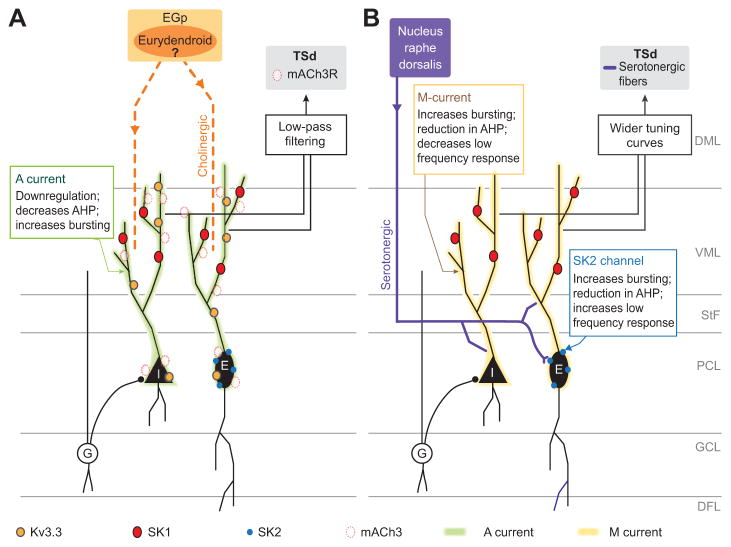Fig. 4.
Summary of the neuromodulation circuitry of the ELL. (A) Cholinergic system. Cholinergic input arising most likely from eurydendroid cells reaches the ELL molecular layer and affects both E- and I-type pyramidal cells. Acetylcholine acts through muscarinic receptor 3 (mAChR3) located in both types of pyramidal cells (Toscano-Márquez et al., 2013). This receptor downregulates an A-type potassium current leading to increased excitability. It also decreases the cell’s AHP, which increases bursting. Additional effects of acetylcholine via SK and Kv3.3 channels are possible. The modulation of pyramidal cell excitability is translated into enhanced processing of low-frequency stimuli. Additional cholinergic effects are expected in the target area of ELL pyramidal cells, the torus semicircularis dorsalis (TSd). (B) Serotonergic system. Serotonin input reaches the ELL through fibres originating in the nucleus raphe dorsalis. The fibres make synapses on the dendrites and somata of E- and I-type pyramidal cells. In both E- and I-cells they downregulate an M-type current. This downregulation increases bursting, reduces the AHP and reduces the response to low-frequency stimuli. Additionally to the M current, 5-HT downregulates SK2 channels in E-type cells. The downregulation of SK2 enhances the processing of low-frequency stimuli (Deemyad et al., 2011). Additionally, it is possible that serotonin modulates SK1 channels in the dendrites of I-type cells. The effects of serotonin on the excitability of pyramidal cells lead to a whitening of the tuning curve of the pyramidal cells. DFL, deep fibre layer; DML, dorsal molecular layer; EGp, eminentia granularis posterior; G, granular cell; GCL, granule cell layer; PCL, pyramidal cell layer; StF, stratum fibrosum; VML, ventral molecular layer.

